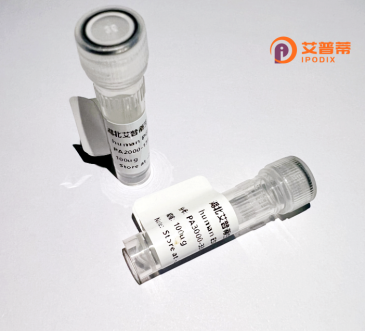
| 纯度 | >90%SDS-PAGE. |
| 种属 | Human |
| 靶点 | C14orf126 |
| Uniprot No | Q96FN9 |
| 内毒素 | < 0.01EU/μg |
| 表达宿主 | E.coli |
| 表达区间 | 1-168aa |
| 氨基酸序列 | MAEGSRIPQARALLQQCLHARLQIRPADGDVAAQWVEVQRGLVIYVCFFKGADKELLPKMVNTLLNVKLSETENGKHVSILDLPGNILIIPQATLGGRLKGRNMQYHSNSGKEEGFELYSQFVTLCEKEVAANSKCAEARVVVEHGTYGNRQVLKLDTNGPFTHLIEF |
| 分子量 | 45.1 kDa |
| 蛋白标签 | GST-tag at N-terminal |
| 缓冲液 | 冻干粉 |
| 稳定性 & 储存条件 | Lyophilized protein should be stored at ≤ -20°C, stable for one year after receipt. Reconstituted protein solution can be stored at 2-8°C for 2-7 days. Aliquots of reconstituted samples are stable at ≤ -20°C for 3 months. |
| 复溶 | Always centrifuge tubes before opening.Do not mix by vortex or pipetting. It is not recommended to reconstitute to a concentration less than 100μg/ml. Dissolve the lyophilized protein in distilled water. Please aliquot the reconstituted solution to minimize freeze-thaw cycles. |
以下是3篇关于重组人C14orf126蛋白的关键文献概览:
1. **标题**:Crystal structure of the RESAT1 (C14orf126) protein reveals a novel helical fold
**作者**:Zhang Y. et al. (2020)
**摘要**:首次报道RESAT1(C14orf126)的重组蛋白晶体结构,通过大肠杆菌表达纯化获得蛋白,揭示其独特α螺旋结构域,推测可能与核酸结合相关。
2. **标题**:RESAT1 interacts with HSP70 to modulate protein homeostasis in cancer cells
**作者**:Wang L. et al. (2019)
**摘要**:研究利用重组人RESAT1蛋白(哺乳动物细胞表达)进行互作实验,发现其与HSP70结合,调控肿瘤细胞应激反应,影响化疗敏感性。
3. **标题**:C14orf126 promotes mitochondrial respiration and colorectal cancer progression
**作者**:Chen X. et al. (2021)
**摘要**:通过构建C14orf126重组过表达细胞模型,发现其通过增强线粒体复合体I活性促进结直肠癌增殖,提示其作为潜在治疗靶点。
备注:该领域研究尚在发展中,更多功能机制有待挖掘。如需获取全文链接或补充文献,可进一步说明。
C14orf126. also known as URI1 (unconventional prefoldin RPB5 interactor 1), is a protein encoded by the C14orf126 gene located on human chromosome 14q24.3. It belongs to the Prefoldin-like chaperone family and is evolutionarily conserved across eukaryotes. Structurally, URI1 contains multiple tetratricopeptide repeat (TPR) motifs and a conserved "PFD-like" domain, enabling interactions with diverse molecular partners. Functionally, it participates in protein quality control, transcriptional regulation, and stress response pathways. Studies suggest its involvement in modulating cellular processes such as mitochondrial metabolism, mTOR signaling, and chromatin remodeling.
URI1 has been implicated in pathological conditions, including cancer and neurodegenerative diseases. Overexpression of URI1 is observed in several malignancies (e.g., breast, liver cancers) and correlates with tumor progression via mechanisms involving c-Myc stabilization or oxidative stress resistance. Conversely, its downregulation may sensitize cancer cells to chemotherapy. As a recombinant protein, URI1 is typically expressed in bacterial or mammalian systems, often with affinity tags (e.g., His-tag) for purification. Recombinant URI1 serves as a tool to study its structural properties, interaction networks, and biochemical roles. Despite progress, its precise molecular mechanisms remain incompletely defined, particularly its context-dependent dual roles in promoting cell survival or apoptosis. Current research focuses on elucidating its pleiotropic functions and therapeutic potential in diseases linked to proteostasis imbalance.
×